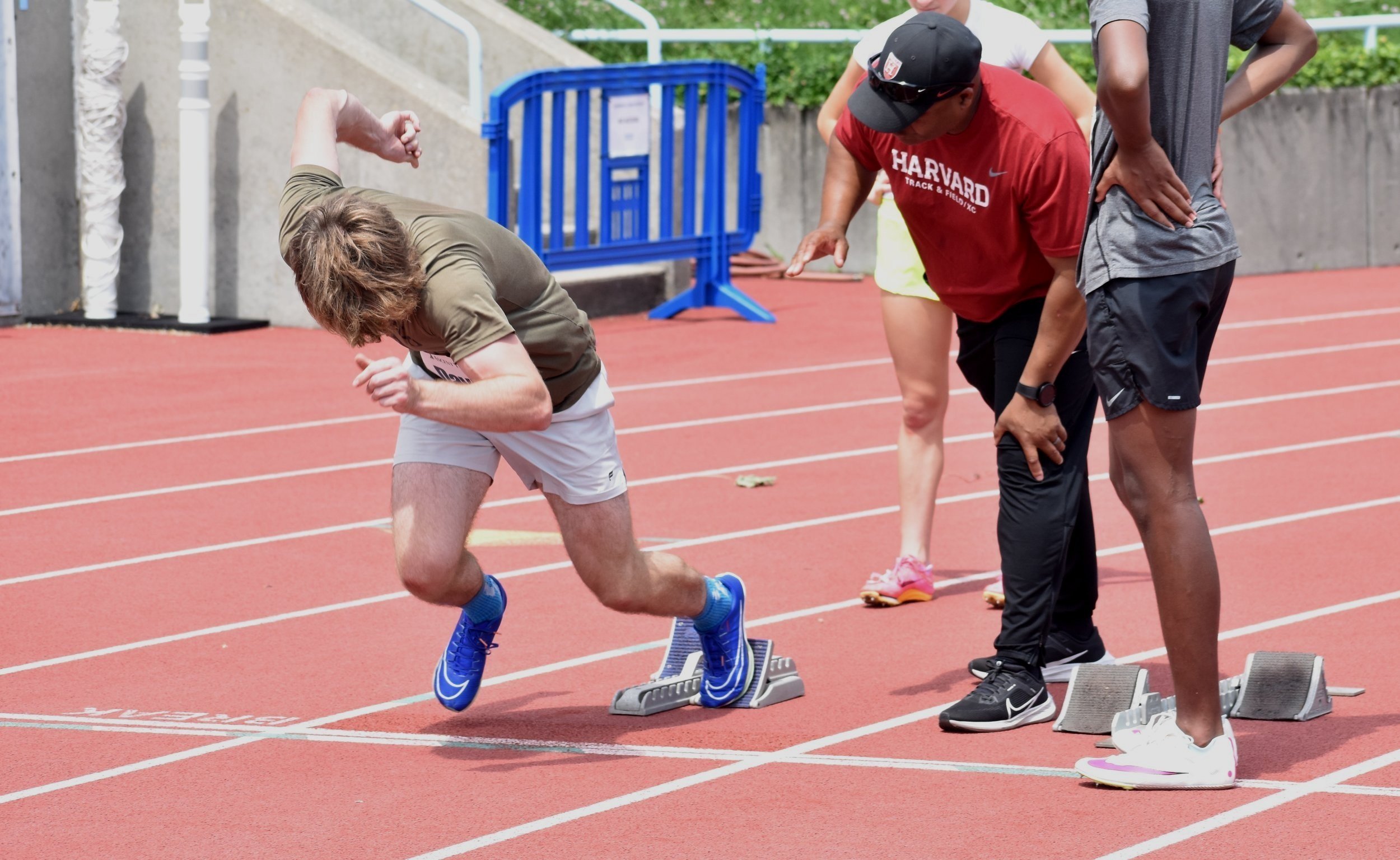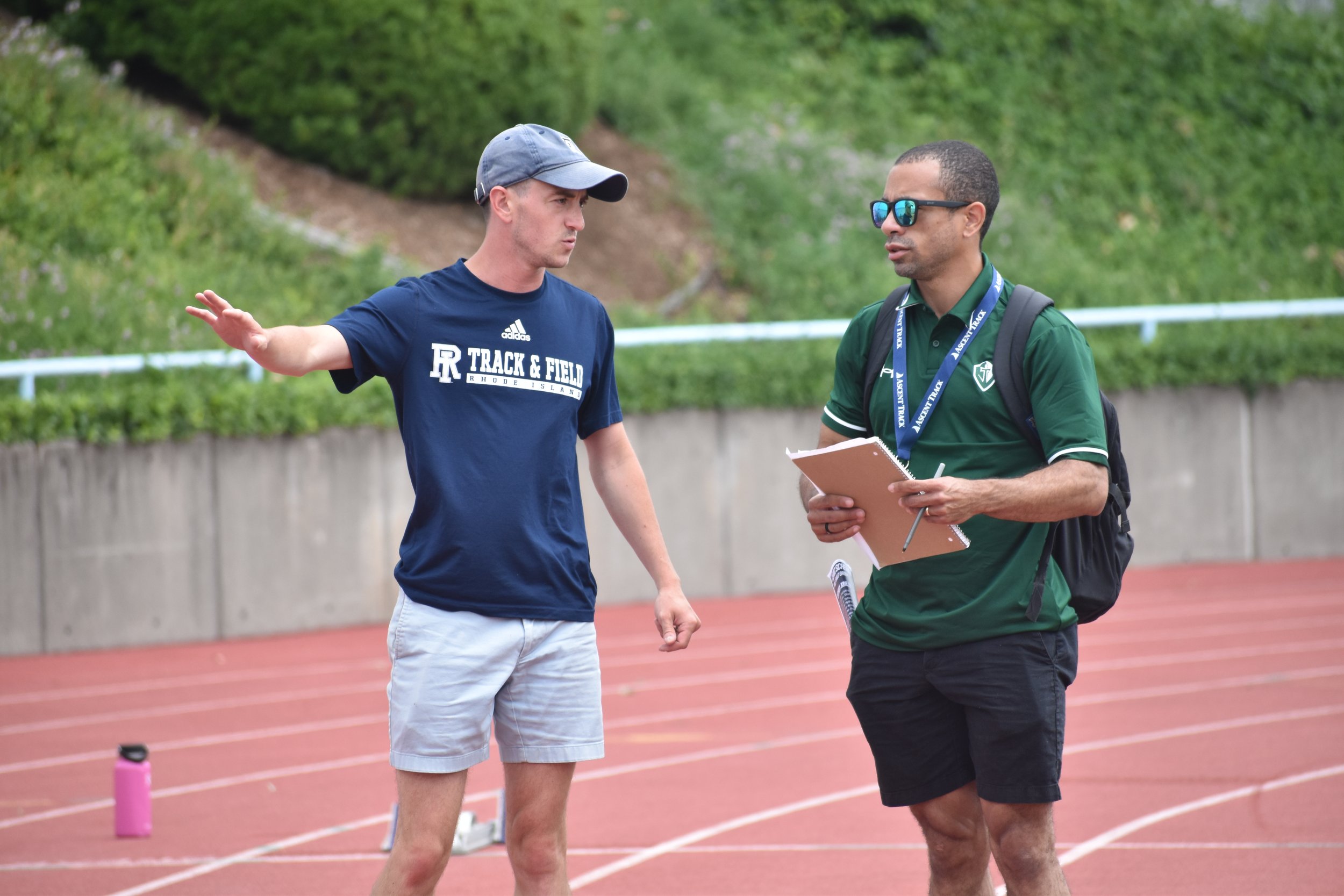
116. The triple jump: Technique and teaching
Immerse yourself in a fully comprehensive, self-paced triple jump instructional from veteran instructor and founder of USTFCCCA’s Track & Field Academy, Boo Schexnayder.
~6 Hrs. Duration | 36 Pages of Course Materials | 10 Knowledge Retention Checks
This course is also included in the Horizontal Jumps Bundle.
Course instructor
BOO SCHEXNAYDER
Director, Consultant, Coach
SAC Speed
With over 40 years of experience in coaching and consulting, Boo Schexnayder is regarded as one of the world’s premier field event coaches.
He was the mastermind behind 26 NCAA Champions during his collegiate coaching career, was part 13 NCAA Championship teams and a pair of Juco National titles, and he has developed a host of conference champions and All-Americans.
Schexnayder has also been a prominent figure on the international scene. He has coached 18 Olympians and 7 Olympic/World Championship medalists, and served on coaching staffs for Team USA to the 2003 Pan Am Games in Santo Domingo, the 2006 World Junior Championships in Beijing, and was the Jumps Coach for Team USA at the 2008 Olympics in Beijing.
-
Schexnayder has been just as successful off the track. He is certified at Level I, II and III, and owns the prestigious Master Coach Designation from USA Track and Field. He is also certified by the NSCA as a Strength and Conditioning coach.
Schexnayder has been heavily involved in Coaching Education. He formerly served as national chair of USATF’s Coaching Education Committee, Jumps Subcommittee chair, and chair of the Biomechanics subcommittee.
Schexnayder was also the founder of the Track and Field Academy, the educational branch of the US Track and Field and Cross Country Coaches Association. He served as program director from its inception in 2009 through 2017, and still serves as an instructor in biomechanics, training design, and event-specific courses.
GET ACCESS:
COURSE DESCRIPTION
A FULLY COMPREHENSIVE TRIPLE JUMP INSTRUCTIONAL
Boo Schexnayder and Todd Lane break down all phases of the event in detail, using video to clearly illustrate every key position and movement. Detailed, step-by-step teaching progressions are shown and cues given for bounding skills and the event itself.
Of special interest is a section dedicated to fixing the troublesome second phase, using flowchart analysis to take you to the roots of step phase problems.
Also included are tips for teaching technique and many many other extra topics. This course includes and identifies special high level technical sections that make it a great resource for every level of Triple Jumper.
This course features archived video content that can now only be found here in this course, while the study notes and knowledge retention checks are new materials that are unique to this course.
GET ACCESS:
COURSE LAYOUT
01. THE APPROACH
This chapter covers step lengths, starting stance, and the four approach phases, setting up a strong start for the triple jump.
VIDEO: The Approach
STUDY NOTES: The Approach
KNOWLEDGE RETENTION CHECK: The Approach
02. THE TRANSITION PHASE
The Transition Phase focuses on the last four approach steps, emphasizing posture, stride length, and preparation for takeoff.
VIDEO: The Transition Phase
STUDY NOTES: The Transition Phase
KNOWLEDGE RETENTION CHECK: The Transition Phase
03. PREPARATION
This chapter explains how the penultimate step should maintain a sprinting stride, avoiding long jump-like preparation to ensure a smooth transition
VIDEO: Preparation
STUDY NOTES: Preparation
KNOWLEDGE RETENTION CHECK: Preparation
04. THE TAKEOFF
This chapter details techniques for preserving horizontal speed, correct foot and leg actions, and arm mechanics during takeoff.
VIDEO: The Takeoff
STUDY NOTES: The Takeoff
KNOWLEDGE RETENTION CHECK: The Takeoff
05. BOUNDING SKILLS
This chapter breaks down bounding into postural, ground contact, swinging segment, and rotational skills, emphasizing their critical role in optimizing the hop, step, and jump phases of the triple jump.
VIDEO: Bounding Skills
STUDY NOTES: Bounding Skills
KNOWLEDGE RETENTION CHECK: Bounding Skills
06. THE HOP PHASE
The Hop Phase focuses on the hop leg and free leg cycles, emphasizing reflexive movements and proper foot placement for balance and efficiency.
VIDEO: The Hop Phase
STUDY NOTES: The Hop Phase
KNOWLEDGE RETENTION CHECK: The Hop Phase
07. THE STEP PHASE
The Step Phase highlights posture, leg swing, and vertical push, with advanced techniques like the Scissor Technique for experienced athletes.
VIDEO: The Step Phase
STUDY NOTES: The Step Phase
KNOWLEDGE RETENTION CHECK: The Step Phase
08. THE JUMP PHASE
The Jump Phase emphasizes posture, swing mechanics, and arm extension to control rotation, ensuring a stable and efficient finish.
VIDEO: The Jump Phase
STUDY NOTES: The Jump Phase
KNOWLEDGE RETENTION CHECK: The Jump Phase
09. THE LANDING
This chapter outlines biomechanical techniques and coaching strategies for maximizing jump distance and minimizing injury during the landing phase
VIDEO: The Landing
STUDY NOTES: The Landing
KNOWLEDGE RETENTION CHECK: The Landing
10. TEACHING BOUNDING SKILLS
Bounding skills are taught through a progression of drills that prioritize posture, pelvic alignment, and controlled transitions from vertical to horizontal motion.
VIDEO: Teaching Bounding Skills
STUDY NOTES: Teaching Bounding Skills
KNOWLEDGE RETENTION CHECK: Teaching Bounding Skills
11. TEACHING PROGRESSIONS FOR THE TRIPLE JUMP
A structured progression integrates the hop, step, and jump phases through drills that build fundamental skills and gradually increase complexity.
VIDEO: Teaching Progressions for the Triple Jump
STUDY NOTES: Teaching Progressions for the Triple Jump
KNOWLEDGE RETENTION CHECK: Teaching Progressions for the Triple Jump
12. FIXING THE SECOND (OR STEP) PHASE
The step phase is used as a diagnostic tool to identify root issues from earlier phases and improve technique through targeted adjustments.
VIDEO: Fixing the Second (or Step) Phase
STUDY NOTES: Fixing the Second (or Step) Phase
CHART: Triple Jump Step Phase Repair Chart
KNOWLEDGE RETENTION CHECK: Fixing the Second (or Step) Phase
GET ACCESS:
What to Expect
EXPERT INSTRUCTORS
Our instructors are proven track & field veterans with experience as educators, program directors, and coaches at the collegiate, professional, and international levels. Each course has been meticulously planned and prepared by its instructor to ensure a comprehensive learning experience for every student.
SELF-PACED LEARNING
Learn on your own terms in our self-paced educational environment. Progress through video lessons, review study guides, and complete knowledge retention checks all on your own schedule. You can even skip sections and return to them later. There’s no time requirement for finishing the course. Once you buy it, you can access it forever.
DOWNLOADABLE CONTENT
Each course includes supplementary documentation – from study guides and glossaries to diagrams and inventories. All of this documentation is downloadable. Save it, print it, and take it with you to practices and meets to make an immediate impact with your newfound knowledge. Videos you can access wherever you have an internet connection.
KNOWLEDGE RETENTION CHECKS
Complete each course confidently with the help of our knowledge retention checks. After every module, these short quizzes test your knowledge of key concepts to ensure your grip on the material is strong.
Knowledge retention checks are optional unless you intend to receive a Certificate of Achievement upon completion, which requires an 80% or better on all.
CERTIFICATE OF ACHIEVEMENT
Showcase your knowledge to administration and staff with a Certificate of Achievement. You’ll have the option to request one of these if you’ve completed every module of the course and passed all knowledge retention checks with a score of 80% or higher.
GET ACCESS:
Frequently asked questions
Don’t see your question below? Contact us.
-
No, you can choose to enroll at any time you’d like, and take however much time you want to; the course will always be there for whatever timeline suits you.
-
Yes and no– it is not possible to download the video lessons, but you can download all PDF materials.
-
There is no time limit to your login, and you can go back and look at any part of the course you want at any time.
-
You must show that you have an understanding of the material by achieving a mark of 80% or higher on the Knowledge Retention Checks– but don’t worry, you can take those Knowledge Retention Checks more than one time if need be.
-
For any course content, we encourage you to write the questions in the Ascent Track Discord in each class section. For any technical issues, you can contact us at support@ascenttrackclinics.com









